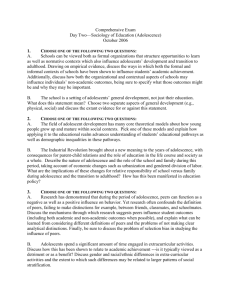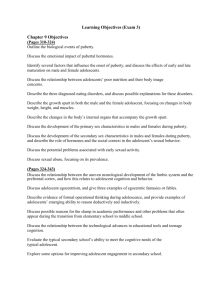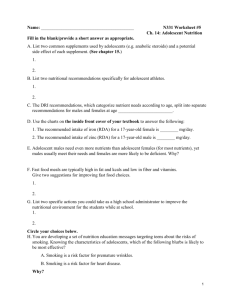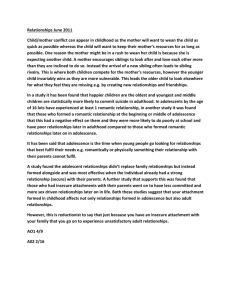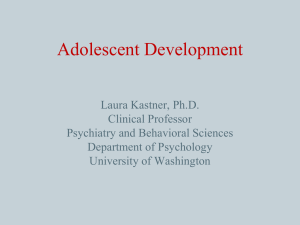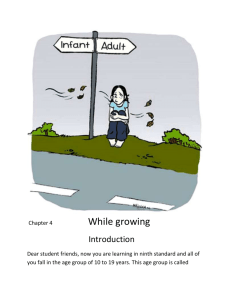Late Adolescence/Young Adulthood (Ages 18 – 24 years)
advertisement
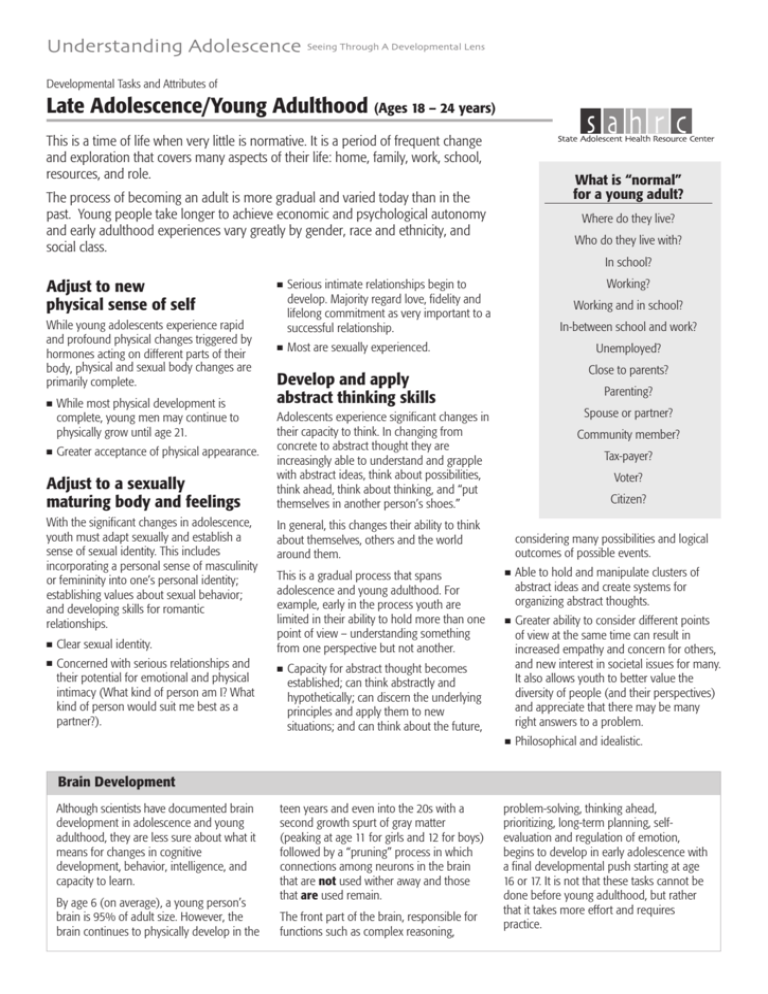
Understanding Adolescence Seeing Through A Developmental Lens Developmental Tasks and Attributes of Late Adolescence/Young Adulthood (Ages 18 – 24 years) This is a time of life when very little is normative. It is a period of frequent change and exploration that covers many aspects of their life: home, family, work, school, resources, and role. What is “normal” for a young adult? The process of becoming an adult is more gradual and varied today than in the past. Young people take longer to achieve economic and psychological autonomy and early adulthood experiences vary greatly by gender, race and ethnicity, and social class. Where do they live? Who do they live with? In school? Adjust to new physical sense of self While young adolescents experience rapid and profound physical changes triggered by hormones acting on different parts of their body, physical and sexual body changes are primarily complete. n n While most physical development is complete, young men may continue to physically grow until age 21. Greater acceptance of physical appearance. Adjust to a sexually maturing body and feelings With the significant changes in adolescence, youth must adapt sexually and establish a sense of sexual identity. This includes incorporating a personal sense of masculinity or femininity into one’s personal identity; establishing values about sexual behavior; and developing skills for romantic relationships. n Clear sexual identity. n Concerned with serious relationships and their potential for emotional and physical intimacy (What kind of person am I? What kind of person would suit me best as a partner?). n n Working? Serious intimate relationships begin to develop. Majority regard love, fidelity and lifelong commitment as very important to a successful relationship. Working and in school? In-between school and work? Most are sexually experienced. Unemployed? Close to parents? Develop and apply abstract thinking skills Parenting? Spouse or partner? Adolescents experience significant changes in their capacity to think. In changing from concrete to abstract thought they are increasingly able to understand and grapple with abstract ideas, think about possibilities, think ahead, think about thinking, and “put themselves in another person’s shoes.” Community member? Tax-payer? Voter? Citizen? In general, this changes their ability to think about themselves, others and the world around them. This is a gradual process that spans adolescence and young adulthood. For example, early in the process youth are limited in their ability to hold more than one point of view – understanding something from one perspective but not another. n considering many possibilities and logical outcomes of possible events. n Able to hold and manipulate clusters of abstract ideas and create systems for organizing abstract thoughts. n Greater ability to consider different points of view at the same time can result in increased empathy and concern for others, and new interest in societal issues for many. It also allows youth to better value the diversity of people (and their perspectives) and appreciate that there may be many right answers to a problem. n Philosophical and idealistic. Capacity for abstract thought becomes established; can think abstractly and hypothetically; can discern the underlying principles and apply them to new situations; and can think about the future, Brain Development Although scientists have documented brain development in adolescence and young adulthood, they are less sure about what it means for changes in cognitive development, behavior, intelligence, and capacity to learn. By age 6 (on average), a young person’s brain is 95% of adult size. However, the brain continues to physically develop in the teen years and even into the 20s with a second growth spurt of gray matter (peaking at age 11 for girls and 12 for boys) followed by a “pruning” process in which connections among neurons in the brain that are not used wither away and those that are used remain. The front part of the brain, responsible for functions such as complex reasoning, problem-solving, thinking ahead, prioritizing, long-term planning, selfevaluation and regulation of emotion, begins to develop in early adolescence with a final developmental push starting at age 16 or 17. It is not that these tasks cannot be done before young adulthood, but rather that it takes more effort and requires practice. Define a personal sense of identity Renegotiate relationship with parents/caregivers Adolescents move from identifying themselves as an extension of their parents (childhood) to recognizing their uniqueness and separation from parents. They develop a sense of self as an individual and as a person connected to valuable people and groups. Adolescents negotiate a change in relationship with parents that begins to balance autonomy (independence) with connection. Overall, the adolescent’s task is one of separating in some ways, while maintaining and redefining connections in others, in order to make room for a more adult relationship that meets cultural expectations and provides necessary support. They refine their sense of identity around issues such as gender, physical attributes, sexuality, ethnicity. They explore issues such as Who am I? How do I fit in? Am I loveable and loving? How am I competent? One result of this is experimentation with different, temporary “identities” by means of alternative styles of dress, jewelry, music, hair, manner, and lifestyle. Teens may struggle to identify a true self amid seeming contradictions in the way they feel and behave in different situations, and with different levels of thought and understanding. n n Firmer sense of identity, although still a time of identity exploration (especially in areas of personal relationships, education, work, family). Age of feeling in-between – see themselves as neither an adolescent nor an adult . Adopt a personal value system Adolescents develop a more complex understanding of moral behavior and underlying principles of justice. They question and assess beliefs from childhood and restructure these beliefs into a personal ideology (e.g. more personally meaningful values, religious views, and belief systems to guide decisions and behavior). n Decisions and values are less influenced by peers. n Able to see multiple viewpoints, value the diversity of people and perspectives and appreciate that there can be many right answers to a problem. n Identify values and viewpoints that work for oneself while respecting viewpoints/values of others n Improved ability to see parents as individuals and take their perspectives into account. n Conflicts with parents often decrease with age. n Renegotiation in parent-child roles, especially for those who live at home (nearly half of all U.S. young adults in their late teens and early twenties still live with their parents). This is important as residential change is highest in late adolescent/young adulthood than any other age group (young people living at home, moving out and living independently or with peers/partners, moving back home, etc). Throughout adolescence, friendships become more stable, intimate and supportive; they provide a cornerstone for learning about adult relationships. n Relate to individual peers more than to peer group. n More mature style of peer relationships (stability, intimacy and supportiveness). n Increasingly more balance between the influence of family and peers on the young person. Meet demands of increasing mature roles and responsibilities Adolescents gradually take on the roles expected of them in adulthood. They learn the skills necessary for these roles and manage the multiple demands of the labor market as well as meet expectations regarding commitment to family, community and citizenship. n Stable interests. n Ability to compromise. n Self-reliance. n Greater concern for others. Develop stable and productive peer relationships n Higher level of concern for the future. n Thoughts about one’s role in life. Peer relationships change during adolescence to provide youth with more support and connections as they spend less time with adults and in supervised activity. n Transition to work, college, independent living. Participation in college education in young adulthood is nonlinear – frequently combined with work and periods of nonattendance in school. n Youth in general remain in school longer and marry later, but those from lessadvantaged households find it harder to adhere to an orderly and predictable sequence of education, full-time employment, home-leaving, cohabitation or marriage, and parenthood. n Work experiences become more focused on laying foundation for adult occupation Peer relationships often compete with parents and schools in influence on teen’s attitudes and behaviors. As networks with peers broaden, peer relationships become deeper and play an increasing role in shaping an individual teen’s self-concept and interaction. Adolescents experience three transformations in peer relationships: 1. Reorientation of friendships from activitybased relationships of childhood to more stable, affectively oriented friendships based on idea and value sharing. 2. Growth of romantic and sexually oriented relationships. 3. Emergence of peer “crowds.” This synthesis of adolescent development research was compiled by K. Teipel of the State Adolescent Health Resource Center, Konopka Institute, University of Minnesota. teipe001@umn.edu 612-624-0182 The State Adolescent Health Resource Center is funded through Cooperative Agreement #U93 MC 00163-01 from the Maternal Child and Health Bureau – Health Resources and Services Administration, Department of Health and Human Services. 2

